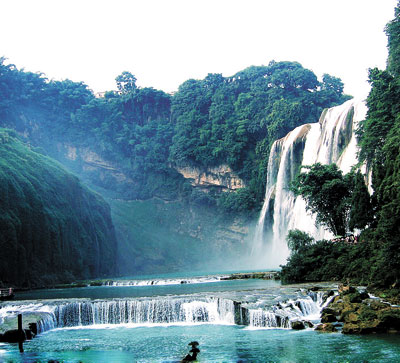
Tan Yifan cicitan2011@gmail.com A VISITOR who arrives for the first time in a mountainous area may be surprised to come across a small waterfall or lake on a winding mountain path, but for a Guizhou resident — especially those who grew up outside the urban areas — such discoveries would come as no surprise at all. Various waterfalls, lakes, and underground rivers are scattered around rural areas of the province, making it nearly impossible to name those considered most beautiful. However, I would like to recommend two scenic regions that have much to offer — Huangguoshu National Park and Libo Zhangjiang Scenic Spot. Huangguoshu National Park is an hour’s journey from Anshun City, which is located in the west of Guizhou Province, and it consists of 18 waterfalls. Huangguoshu Waterfall and Tianxing Landscape are the two must-see spots for those who have just one day to spare. Named after the local fruit “huangguo” [黄果], a variety of orange, Huangguoshu Waterfall is the third-largest waterfall in the world — after Niagara Falls in North America and Victoria Falls in southern Africa — with a height of 77.8 meters and a width of 101 meters. Many Chinese are familiar with this waterfall as it was shown in the classic hit teleplay “Journey to the West” in 1982. Visitors often feel it necessary to speak loudly and wear a raincoat at the waterfall as the area is covered in spray and the noise is overwhelming — but also exciting. Along the narrow footpath visitors can stop at a water-viewing pavilion, and the footpath actually cuts through the waterfall, which allows explorers to walk and stay behind the water curtain. A water-curtain cave which has room for about three adults is one of the popular attractions. After leaving the cave, visitors walk down the path and reach the foot of the waterfall where a middle-sized lake features a stone path that leads to the other side of the lake. A special viewing platform nearby gives photo enthusiasts an opportunity to take a picture of the whole waterfall. Next to the main waterfall is Tianxing Landscape which showcases karst landscape. The view looks like a stone forest on the water, and a karst cave and smaller waterfalls look like stones covered by silver pendants. Visitors who are not pressed for time can walk about 7 kilometers to have a look at Hongya Tianshu — Red Cliff Words Carvings — which is believed to have been carved around the period of the Three Kingdoms (220-280). Nobody has managed to decipher the meaning of the carvings. The national park is also an ideal destination for hikers to spend at least two days. It is highly recommended to start the walk from Shitouzhai — which means stone village — located on the upstream of Baihui River, the source of all the waterfalls. Known for houses made of stone, Shitouzhai, the home of the Buyi minority, preserves the culture of batik (wax printing). Hikers can walk along the footpath and across waterfalls, making a stopover at Guanling ancient route and finally reaching Hongya Tianshu where they can rest at Hungguoshu Hotel and take a bus to Guiyang City, the capital of Guizhou Province. Another place that is worth exploring especially in the hot summer is Libo Zhangjiang Scenic Spot, which is 28 kilometers away from Libo County, a relatively small and quiet place in the south of Guizhou Province. Sometimes referred to as a “green gem,” the scenic spot features karst forests and various waterscapes — lakes, underground rivers and waterfalls as well as caves and valleys. It was named a World Natural Heritage site in 2007 for its fine karst scenery that is rarely seen in the subtropical zone along the same latitude. Entering the forest is like stepping into a large air cleaner as the spray from the water makes the air cool and fresh. The 12-kilometer-long Xiaoqikong Scenic Zone which is known for its flat gem-like lake and a stone bridge with seven bridge openings is one of the most popular attractions. In addition, tourists may marvel at a 68-layer Laya Waterfall, Mandrain Duck Lake and Sleeping Dragon Pool that seem to be colored a mixture of light blue and green. Spending a day among the greenery, visitors will have the chance to appreciate the spectacular views that change according to sunlight, rain and fog. Recommended routes: Huangguoshu National Park: Fly from Shenzhen to Guiyang and take a shuttle bus to Huangguoshu National Park. The entrance fee is 180 yuan from March to November and 160 yuan from December to February. Backpackers should bring moisture-proof equipment and mosquito repellent if they spend the night. Libo Zhangjiang Scenic Spot: Fly from Guangzhou City to Libo County and take a shuttle bus to Libo Zhangjiang Scenic Spot. Entrance is 90 yuan. | 
